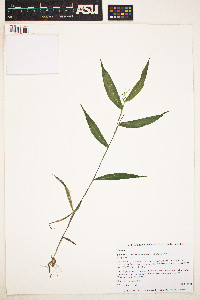|
|
|
|
Family: Poaceae
variable panicgrass
[Dichanthelium commutatum (Schult.) Gould, moreDichanthelium commutatum var. ashei (T.G.Pearson ex Ashe) Mohlenbr., Dichanthelium joorii (Vasey) Mohlenbr., Panicum ashei T.G.Pearson ex Ashe, Panicum commutatum var. ashei (T.G.Pearson ex Ashe) Fernald, Panicum commutatum var. joorii (Vasey) Fernald, Panicum equilaterale Scribn., Panicum joorii Vasey, Panicum mutabile Scribn. & J.G.Sm.] |
Plants cespitose, with caudices or with rhizomes up to 2 mm thick. Basal rosettes well-differentiated; blades 1-14 cm long, to 22 mm wide, ovate to lanceolate. Culms 20-75 cm, erect or decumbent to sprawling, often purplish; nodes and internodes glabrous or puberulent to pubescent; fall phase initially nearly erect, often sprawling eventually, branches initially erect and apparently dichotomous, later rebranching, blades and secondary panicles smaller than those of the culms. Cauline leaves 4-6; sheaths not overlapping, often glaucous, purplish, or olivaceous, glabrous or puberulent, margins usually ciliate; ligules about 0.3 mm, membranous, ciliate, cilia longer than the membranous portion, rarely with adjacent, about 12 mm hairs; blades 5-16 cm long, 5-25 mm wide, linear to ovate-lanceolate, glabrous or puberulent, with 9-13 major veins and 30-80 minor veins, bases cordate-clasping, often asymmetrical, with papillose-based marginal cilia. Panicles 5-12 cm long, 3-10 cm wide, open, exserted; branches flexuous. Spikelets 2.2-3.2 mm long, 1.1-1.3 mm wide, ellipsoid, yellowish-green or purplish, pubescent. Lower glumes 0.7-1.8 mm; upper glumes and lower lemmas equaling or slightly shorter than the spikelets; lower florets sterile; upper florets often minutely umbonate. 2n = 18. Dichanthelium commutatum is fairly common in dry to wet, semi-open woodlands. Its range extends from the eastern United States to South America. The primary panicles are open-pollinated and are produced from April through June; the secondary panicles are primarily cleistogamous and are produced from June through fall. The four subspecies are fairly distinct in some parts of their ranges, but subsp. commutatum intergrades with the other three where they occur together. Perennial herb, tufted 20 cm - 0.75 m tall Inflorescence: a terminal, branched arrangement of spikelets (panicle). Panicles atop the culms, open, 5 - 12 cm long, 3 - 10 cm wide, exserted. Secondary panicles (when present) atop the branches. Fruit: a caryopsis, indehiscent, enclosed within the persistent lemma and palea. Culm: upright or decumbent to sprawling, often purplish, 20 cm - 0.75 m long, round in cross-section, hollow, sometimes minutely hairy to hairy on nodes and internodes. Fall phase nearly upright, eventually sprawling, sparsely rebranching, producing leaf blades and secondary panicles that are smaller than those of the culms. Spikelets: purplish or yellowish green, 2 - 3 mm long, over 1 mm wide, narrowly ellipsoid, and hairy. Basal leaves: in a rosette. Blades 1 - 14 cm long, to 2 cm wide, egg-shaped to lance-shaped, distinct from stem blades. Stem leaves: four to six, alternate, two-ranked. Sheaths purplish or olive-colored, usually shorter than internodes, often having a waxy coating (glaucous), sometimes minutely hairy, often fringed with hairs. Ligules less than 0.5 mm long, shortly membranous, fringed with hairs (hairs longer than membranous area). Blades distinctly longer and narrower than basal leaves, 5 - 16 cm long, 0.5 - 2.5 cm wide, linear to egg- lance-shaped with a clasping, heart-shaped base, often asymmetrical basally, many-veined, sometimes minutely hairy, fringed with bumpy-based hairs. Glumes:: Lower glumes 0.5 - 1.5 mm long. Upper glumes equal to or slightly shorter than spikelets, rounded to pointed at the apex. Lemmas:: Lower lemmas similar to upper glumes, equal to or slightly shorter than spikelets. Upper lemmas longitudinally lined, shiny, with rolled-up margins above. Paleas:: Lower paleas shorter than lower lemmas, thin. Upper paleas longitudinally lined. Florets:: Lower florets sterile. Upper florets bisexual, stalkless, plump, often bearing a tiny protuberance at the apex. Anthers three. Stigmas red. Similar species: No information at this time. Habitat and ecology: No information at this time. Occurence in the Chicago region: native Etymology: Dichanthelium comes from the Greek words di, meaning twice, and anth, meaning flowering, referring to plants that may have two flowering periods. Commutatum means changing. Author: The Morton Arboretum Culms few-several, erect, ascending, or rarely decumbent at base, 3-8 dm, glabrous to sparsely villous or crisp-puberulent; herbage often purple-tinged or ±glaucous; sheaths ciliate to puberulent on the back; ligule none or very short and erose; blades lanceolate, the larger ones 5-12 cm נ7-18 mm, many-nerved, glabrous on both sides, usually sparsely ciliate at the cordate-clasping base; flag-lf nearly or fully as large as those next below; primary panicle eventually exsert, ovoid with spreading or ascending branches, 5-12 cm; spikelets obscurely short-hairy or glabrous, ellipsoid or oblong-ellipsoid, 2.1-3.4 mm, obscurely pointed; first glume two-fifths or half as long (0.7-1.7 mm), triangular-ovate, subacute; second glume and sterile lemma about equaling or often slightly exceeding the fr; autumnal phase branched from the middle and upper nodes, the uppermost primary internode deciduous, the blades not much reduced, the panicles ±reduced and commonly partly included at base; 2n=18. Woods and
thickets; Mass. to Mich. and Mo., s. to Fla. and Tex. (P. ashei; P. joorii; P. mutabile; Dichanthelium c.) Gleason, Henry A. & Cronquist, Arthur J. 1991. Manual of vascular plants of northeastern United States and adjacent Canada. lxxv + 910 pp. ©The New York Botanical Garden. All rights reserved. Used by permission. |



